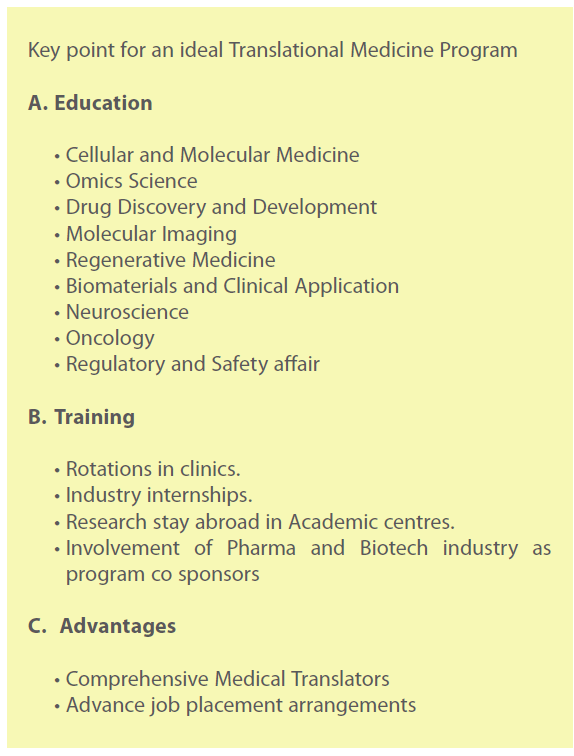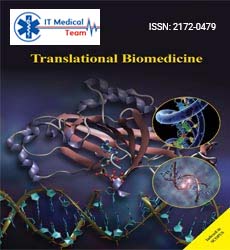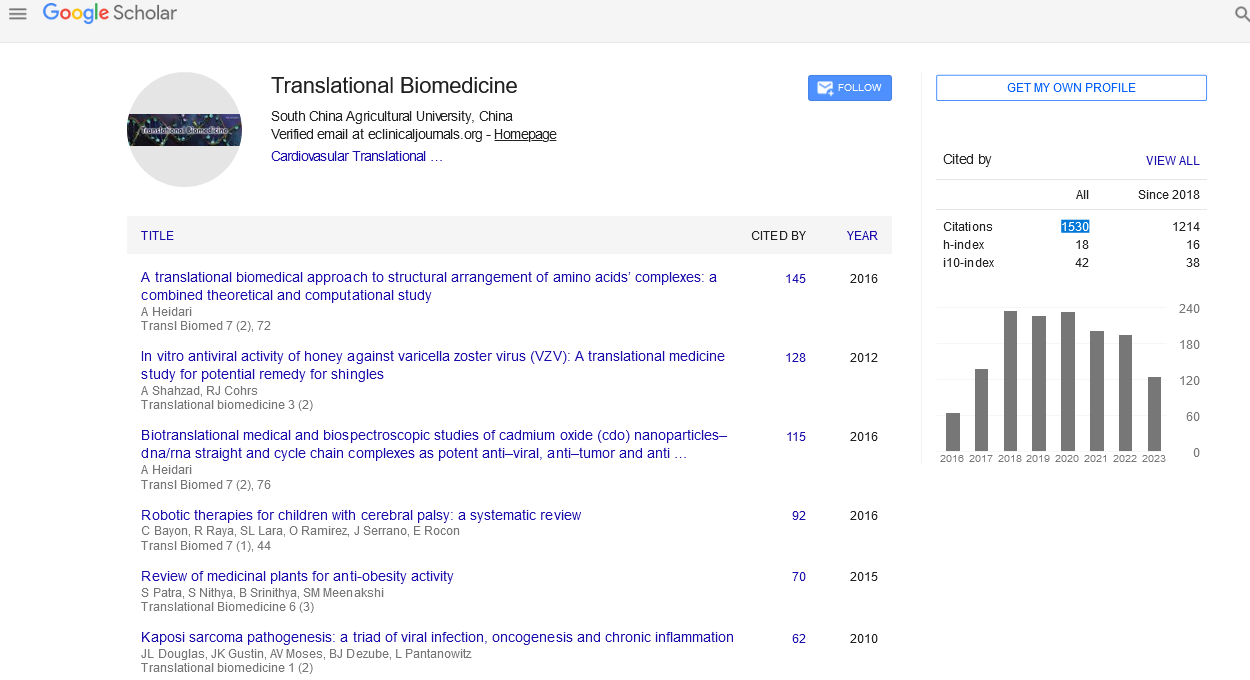Aamir Shahzad1*, Randall J Cohrs2, Roland Andersson3, Xiangdong Wang4 & Gottfried Köhler1
1Department for Biomolecular Structural Chemistry, Max F. Perutz Laboratories, University of Vienna, Austria.
2Departments of Neurology, University of Colorado Health Sciences Center, Denver, Colorado, USA
3Department of Clinical Sciences, BMC F10, Lund University Hospital, Lund, Sweden.
4Department of Clinical Sciences, BMC F10, Lund University Hospital, Lund, Sweden.
- *Corresponding Author:
- Dr Aamir Shahzad
Department for Biomolecular Structural Chemistry
Max F. Perutz Laboratories, University of Vienna
Austria
E-Mail: aamir.shahzad@univie.ac.at
Why are TM programs needed?
In recent past, translational medicine has gained significant importance due to its promising role for accelerating product R&D in pharma and biotech industries. [1,2] Despite large budgets and infrastructure advancements, new drug approvals have declined.[3-5] Translational medicine approaches have the potential to guide all stages of product development leading to rapid and effective product development. [6,7] However, the general scientific community is not fully aware of the concept and objectives entailed in Translational medicine/Translational research. To achieve the full benefits and promising applications from translational medicine, a specifically tailored translational medicine educational/training program must be developed. [8,9] Herein, we discuss such a program.
Aims and objectives
The main goal of any translational medicine educational/ training program is to produce a force of highly skilled, professional ‘Medical Translators’; key players involved in accelerating product R&D in the health care, biotechnology and pharma industries. TM program will provide curricula focusing on translation of scientific discoveries into practical application either for diagnostics, therapeutics, and treatments purposes.
Program level & entry requirement
TM program is ideally suited for the master’s level. To increase diversity and spectrum of the TM program, candidates from medical, biotechnology, pharmacy, chemistry, biophysics, molecular biology and genetics fields are encouraged to enter the program.
TM curricula
Medical Translator must gain a full understanding of human medicine principles including disease progression, basic and human pharmacology, along with an in-depth knowledge of clinical trials, regulatory agencies and industrial business affairs. TM curricula will address these areas with special emphasis given to cellular and molecular medicine, drug discovery and development, molecular imaging, omics science, regenerative medicine, biomaterials and clinical application, neurosciences, and oncology.
Cellular and Molecular Medicine, a critical discipline in TM, forms the basis in the development of devices and assays used in most field within molecular diagnostics, bioengineering, and nanotechnology. Drug Discovery and Development subject involves target identification and validation, drug screening and pharmacology, pharmaceutical science, vaccines, pharmacogenomics, and clinical trials. Omics Science, another important TM discipline, involves the science and technology related to genomics, proteomics, metabolomics, celleomics, and bioinformatics. Molecular Imaging includes medical physics, diagnostic radiology, biotechnology, chemical pathology, histopathology, and cytogenetic biology. Regenerative Medicine focuses on the science and biotechnology associated with stem cells, tissue repair and remodeling, along with tissue engineering. Biomaterials and Clinical Application involves TM relevant biophysics, mechanical, physical, chemical and biological properties, design and production characteristics of devices. Neuroscience is a board discipline including the science related to cognitive science, psychiatry, neurology, neurosurgery, and neuropathology. Oncology study concentrates on target identification, validation, targeting therapy, intervention, biomarkers, gene therapy and related science.
Specialized tracts
1. Drug Discovery & Development is suited to students looking for a career in pharma industry. TM offers great potential to accelerate drug D&D. Students in this tract will gain detailed knowledge and understanding concerning all stages and phases of drug discovery & development. They will also become familiar with regulatory and safety regulations and affairs essential and specific to the pharma industry. They will learn how to develop promising surrogate biomarkers. In principle, they will be trained to become future leaders and key players essential to the pharma industry.
2. Biotechnology tract is suited to those looking for a career in the biotech industry. TM courses are specifically designed to provide detailed knowledge concerning product development, regulatory agencies and business affairs related to biotech. Through industry rotation, students will observe, first-hand, the hurdles encountered in product development and learn from experts how to design potential solutions. Students will obtain extensive training in the disciplines which are necessary for product development: omics, biomaterials and clinical application.
3. Academic research tract is suited to those who wish to establish themselves as group leaders in research field. Students will obtain comprehensive knowledge of clinical terminology and will learn research techniques and skills essential for successful laboratory research careers. These skills will help the student bridge basic and clinical fields. Upon completion, the student will be able to translate effectively the basic research studies into useful clinical diagnostic or therapeutic products.
Rotations/Internships
Rotation and internships in pharma, biotech industry and clinics are compulsory parts of the TM program. During clinics rotations, candidates become familiar with patient interviews: obtaining patient history, developing differential diagnosis, developing decision making skills pertaining to tests relevant to various clinical disorders and understanding various therapeutic approaches. Through their interaction with different patient groups, students will be trained to understand diverse clinical problems/questions and which can be addressed with further laboratory research. Student rotation and internships in industry will provide the venue to translate theoretical knowledge into practical environments. Students will observe all stages of product R&D including the practical hurdles encountered along the way. Regulatory and safety issue awareness will also be covered. In the industry setting, the students will enhance their interpersonal communication skills.
Research Stay Abroad
International Society for Translational Medicine (https://www. stmed.org) under its ‘ISTM collaborative centers program’ has established various academic, clinical, and industrial collaborations around the globe. The participating prestigious academic institutes and hospitals will actively contribute to TM advancement and progress by offering short term/semester research opportunities where students gain international professional and cultural experience.
Role of Industry
Pharma and biotech industry will be involved in the TM educational program and training. Industry will provide internships and rotation opportunities, as well as student scholarships and awards. International Society for Translational Medicine provides industry sponsorship opportunities for various affiliated TM educational and training programs. As Future Medical Translators, successful TM students will obtain advance job placement opportunities from industry.
Role of International Society for Translational Medicine
A major goal of the International Society for Translational Medicine (ISTM) is to produce future TM leaders through education, training, and internship programs. ISTM consists of high profile clinician/scientist from around the globe who provide expert faculty for TM programs and training activates. Additionally, ISTM hosts a job bulletin where candidates submit detailed CVs, and where employers find qualified applicants. The Society functions as a bridge between Future Medical Translators and industry to the success of all involved.

Table 1: Key point for an ideal Translational Medicine Program
2545
References
- Goldstein, J.L. and M.S. Brown, The clinical investigator: bewitched, bothered, and bewildered--but still beloved. J Clin Invest, 1997. 99(12): p. 2803-12.
- Coller, B.S. and R.M. Califf, Traversing the valley of death: a guide to assessing prospects for translational success. Science translational medicine, 2009. 1(10): p. 10cm9.
- Kola, I. and J. Landis, Can the pharmaceutical industry reduce attrition rates? Nature Reviews Drug Discovery, 2004. 3(8): p. 711-715.
- Dimasi, J.A., Risks in new drug development: approval success rates for investigational drugs. Clinical pharmacology and therapeutics, 2001. 69(5): p. 297-307.
- Munos, B., Lessons from 60 years of pharmaceutical innovation. Nature Reviews Drug Discovery, 2009. 8(12): p. 959-968.
- O’Connell, D. and D. Roblin, Translational research in the pharmaceutical industry: from bench to bedside. Drug Discov Today, 2006. 11(17-18): p. 833-8.
- Sultana, S.R., D. Roblin, and D. O’Connell, Translational research in the pharmaceutical industry: from theory to reality. Drug Discov Today, 2007. 12(9-10): p. 419-25.
- Skarke, C. and G.A. FitzGerald, Training translators for smart drug discovery. Sci Transl Med, 2010. 2(26): p. 26cm12.
- Portilla, L.M., et al., Advancing translational research collaborations. Science translational medicine, 2010. 2(63): p. 63cm30.






